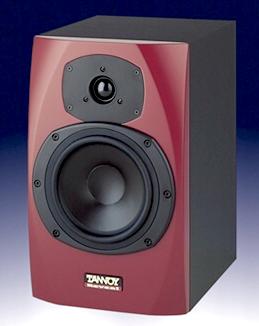Product Review - Tannoy Reveal
Near-Field Studio Monitor Speakers - August, 2000
Milan Cernohorsky - Editor, EUROPE
![]()
|
|
Tannoy Reveal Near-Field Studio Monitor Speakers Playback Studio Monitor for Near-Field Use One 1" Soft Dome Tweeter, One 6 1/2" Woofer, Bass-Reflex MFR: 65 Hz - 20 kHz Sensitivity: 93 dB/w/m Impedance: 6 Ohms Nominal Power: 30 - 100 Watts Size: 13 1/4" H x 8 1/4" W x 10 1/4" D Weight: 15 1/2 Pounds Each Finish: Brown and Grey Vinyl MSRP: $499/pair |
| Tannoy-TGI North America; Phone 519-745-1158; Web http://www.tannoy.com. |
Introduction
It has been quite a while since I last visited the realm of professional, studio speaker systems. This time, I came across little Tannoy Monitor Speakers called "Reveal". It was not my first encounter with them since they were introduced to me this past summer. However, now I was able to take a closer look at them. I found out that a friend of mine, a member of the Czech Philharmonic, owns a pair and so without any ado I confiscated them temporarily to satisfy my desire. I wrapped them carefully in an old army blanket, tied a reliable rope round them, and galloped home.
General
Description
Studio monitors are designed as near-field, meaning you are supposed to sit close to them when listening. The reason is that the farther you sit from the speaker, the more the room enters into what you hear. For the studio, listening to audio tapes that were just recorded, it is important to hear only what is on the tape, not influenced by the room. What this means is that the monitor itself can be optimized for listening at one position, rather than for all types of listening, and this makes it easier for the designer to produce a very high quality product.
The Reveal is a little (340mm x 210mm x 260mm) two-way speaker system. The front sounding board is made of a 40 mm thick MDF (this is very thick) beveled at the corners, while the remainder of the enclosure is made of 16 mm board. The box is, considering its size, very solid and does not resonate when being knocked. The speakers are magnetically shielded so that they can be placed near a computer or a TV set. The finish of the enclosure is perfect, and the hard lacquer looks really nice. The front is satin red, the rest is grey. The color combination seems a little unusual to me, but this is a studio monitor, not a living room speaker. The bass reflex port is located on the rear along with a pair of gold-plated binding posts. There is no grille. The system is designed to be used in a vertical position, so do not even think about laying it sideways.
Sound
I was anxious to compare the
system with my Energy C-2 and Audax 1300 speakers. Price-wise, they were
all almost the same.
Since the Reveal system had
been in use for some time, I did not have to go through an initial break-in
period. I placed them on my Mission stands, where they seemed at home. For two
days I let the speakers get used to my Yamaha amplifier and the cables. Then I
tested them with my favorite ECM recordings, namely, Dave Holland Quintet -
CD "Prime Directive�, Terje Rypdal "Skywards�, and "Khmer� by the
multi-instrumentalist Nils Petter Molvaer and his group. This array of CDs
comprises classical, jazz, and rock, acoustical as well as electronic music.
My first impression was very
good. Compared with the Energy system, the sound was more balanced, smooth, and
without noticeable peaks. I could listen for a long time, very loud, without noticing any
fatigue. Among other factors, this indicates a low level of distortion.
The Bass: Really deep
sounds were not quite there, but mid-lows were projected fully, firmly, and
with no sign of rumble.
The Bass-drum (impact): Very
impressive, its head seemed to be on the verge of rupturing, dynamic,
concrete.
The Winds: Natural sounding,
even the most subtle details of "air transportation� both within the
instrument and the musician were noticeable.
The Voice: Does not stick
out, it is nicely located between the monitors.
The Piano: Now show me what
you have to offer, Tannoy. Too bad, I did not catch them there either.
Actually, I must admit that I have not heard such a natural sounding piano
from a small system for a long time.
Well, what is there left to say? Maybe, just that it is a monitor of the kind I like. It does not give you too much bass, but overall has a well balanced sound quality. It gives you details that other (even more expensive) systems cannot even dream about. It reconstructs the proper space of recordings very well. I must admit that the Reveal system would knock my Energy out in the first round thanks to its more neutral sound. It even managed to keep up with the Audax speakers, although the Audax was still slightly smoother with the treble.
Apart from studios, these speakers can also be well adapted for home use, but their prime location would be for such situations as placement on a bookshelf in front of your desk, so that you sit at the proper distance (about 4 feet).
Other components used in this review:
Energy
C-2 Speakers
Audax 1300 Speakers
Yamaha AX-590 Power Amplifier
Musical Fidelity A-2 Integrated Amplifier
DH Labs SilverSonic Interconnects
IXOS-603 Speaker Cables
- Milan Cernohorsky -
![]()
� Copyright 2000 Secrets of Home
Theater & High Fidelity
Return to Table of Contents for this Issue.


